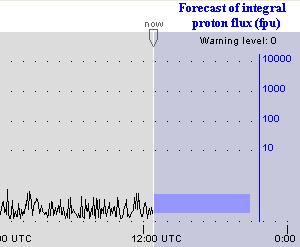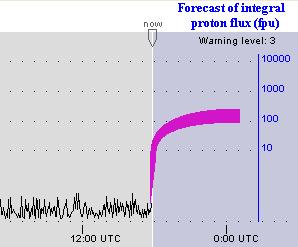UMASEPForecaster (in discussion)
University of Malaga - Solar Energetic Particle Event Forecaster
Developer
University of Malaga, Space Weather Research Group, Spain
Technical Group
Spacecraft & Aircraft Effects
Service objective
Automated real-time prediction of Solar Energetic Proton (SEP) events.
Products
- Real-time prediction of the onset and intensity of well-connected SEPs (Version 2.0).
- Real-time prediction of the onset of poorly-connected SEPs (Beta version).
Link to Project Website
http://spaceweather.uma.es/
Service description
In order to predict well-connected SEPs,
the UMA SEP Forecaster identifies if there exists a magnetic connection between the
associated flare and the Earth, by correlating X-ray and differential proton
data at 1 AU.
The correlation analysis is performed by using a signal processing
technique, specifically designed for this domain, which estimates the
level of connectivity and he traversal time of the first particles from
the solar region to the Earth during the well-connected event.
This forecaster also
predicts the onset of poorly-connected SEPs by estimating log-linear
increasing rates of protons at different energies as the observer is better
connected to the shock nose from behind.
The graphical output of this forecaster is presented in figure 1,
which shows the expected evolution of the integral
proton flux (E>10MeV) during the first hours of the event.
 |
Fig. 1. As an example, the upper time series shows
Integral Proton Flux (E>10 MeV) from a given timespan,
as well as the predicted flux for the next hours.
The middle time series shows the current
solar activity in terms of X-rays.
The lower time series shows the
estimated magnetic connection. The forecast is graphically presented
in the upper-right area.
|
The following figures below illustrate the possible
scenarios and how the SEP forecaster shows them.
 |
 |
Fig. 2. Prediction of a quiet scenario
in terms of well-connected proton flux (E>10MeV).
No well-connected SEP event is expected.
|
Fig. 3. Prediction of a well-connected SEP event.
It graphically shows the expected onset and peak intensity
of the prompt component (first hours) of the SEP.
|
The warning level of the forecast is shown at the top of the highlighted area, at the
right of the forecast panel (see above):
- Warning level=0 means that a well-connected SEP event is not expected.
- Warning level=1 means that a high magnetic connectivity has been detected.
It also means that a well-connected SEP event is not expected.
- Warning level=2 means that an integral proton flux enhancement is expected.
It also means that a well-connected SEP event is not expected.
- Warning level=3 means that a well-connected SEP event is expected.
The details are shown graphically and summarized below the highlighted area.
- Warning level=4 means that a SEP event is occurring.
This forecaster has been evaluated extensively,
using historical 5-minute resolution data from cycles 22 and 23.
Please go to the UMA
performance evaluation
page for more details.
Contact / Manager
Marlon Núñez
| Address: |
LCC, Campus
de Teatinos,
Universidad de Málaga
Málaga, 29017
Spain
|
| E-mail: |
mnunez@uma.es |
| Telephone: |
+34 661 137 988 |
|



